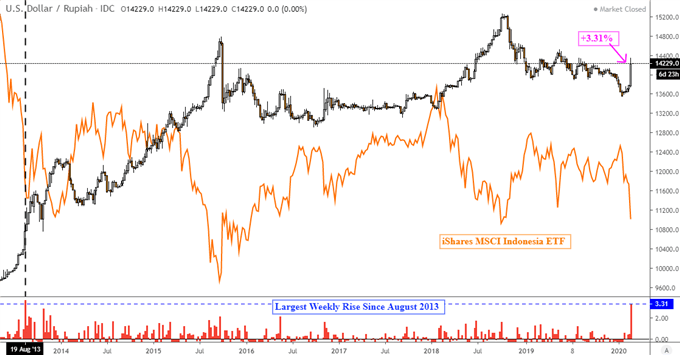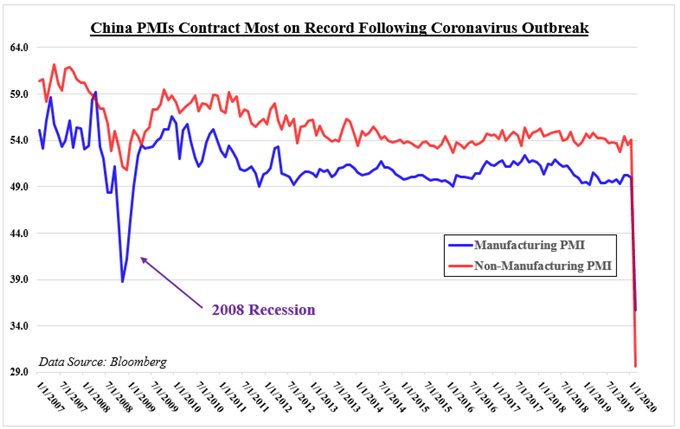Singapore Dollar, Malaysian Ringgit, Indonesian Rupiah, Philippine Peso – Talking Points
- US Dollar held its ground despite rate cut bets as stock markets declined globally
- Singapore Dollar, Indonesian Rupiah, Malaysian Ringgit, Philippine Peso may fall
- Risks: China PMI, capital outflow pressures, coronavirus, equities tumble further
US Dollar ASEAN Weekly Recap – Wall Street’s Worst Performance Since 2008
Last week, the haven-linked US Dollar experienced a mixed performance against its major counterparts. With a few exceptions, this dynamic extended into ASEAN currencies such as the Singapore Dollar, Malaysian Ringgit and Philippine Peso. The one notable standout was the Indonesian Rupiah, which over the course of 5 trading days, declined 3.31% in value as USD/IDR soared.
Fears of the coronavirus were front and center for driving market volatility as most new cases began emerging outside of China. Those from South Korea topped 2,000 with reports emerging outside of Iran and even from the United States. It was the worst week for the MSCI Emerging Markets Index since 2016 as Wall Street declined the most since 2008.
This led to aggressive dovish expectations from the Federal Reserve, undermining the US Dollar to a certain extent from a yield perspective. Future rate cuts threaten its edge against some of its major peers. The Malaysian Ringgit was caught in political uncertainty as Prime Minister Mahathir Mohamad unexpectedly resigned, temporarily fueling concerns about fiscal stimulus.

Recommended by Daniel Dubrovsky
Forex for Beginners
Indonesian Rupiah Tumbles Following Capital Outflow Pressures, More Ahead?
USD/IDR was a notable standout, experiencing its largest rise over a week since August 2013 on the chart below. The local Jakarta Stock Exchange Composite Index approached bear market territory, falling roughly 7% over 5 days in the worst month in six years. According to the Bank of Indonesia, the nation experienced a roughly 26.7t Rupiah net foreign outflow as capital fled, pressuring IDR – as expected.
The Bank of Indonesia stepped in and intervened in markets to help stem a selloff in the Rupiah. It offered to purchase about 2 trillion IDR in sovereign bonds as it said that it will remain in the market to promote stability. From a technical standpoint, USD/IDR soared through a key falling trend line which could pave the way to further gains in the near term.


Recommended by Daniel Dubrovsky
Traits of Successful Traders
USD/IDR, iShares MSCI Indonesia ETF Daily Chart
ASEAN FX at Risk as China Economic Activity Grinds to a Halt, Bank of Malaysia Next
The week ahead continues to pose a downside risk for ASEAN currencies from a sentiment perspective if capital outflow pressures gain momentum. In addition to rising cases of the coronavirus, Chinese composite PMI data on Saturday revealed that manufacturing and non-manufacturing activity shrank at the most aggressive pace on record in February. These even surpassed lows following the 2008 financial crisis.
The world’s second-largest economy is poised to slow in the near-term. Indonesia, Singapore, Malaysia and the Philippines have key trading relationships with China. These concerns may pressure the Bank of Malaysia to deliver a second consecutive rate cut at Tuesday’s policy announcement. That may bode ill for the Malaysian Ringgit as USD/MYR tests potential upside breakout points.
Starts in:
Live now:
Mar 04
( 01:03 GMT )

Recommended by Daniel Dubrovsky
What Do Other Traders Buy/Sell Bets Say About Price Trends?
ASEAN and China Economic Event Risk – PMIs, CPI, Trade
While sentiment may be a key driver for ASEAN currencies such as SGD, IDR, PHP and MYR, there are a few local event risks to keep a tab on. As the week gets rolling, Markit PMI data will cross the wires for Malaysia, Indonesia and the Philippines on Monday. These will be for February and investors will be able to gauge the impact of the coronavirus and a China slowdown on local economic activity.
Caixin China manufacturing PMI is also due during the same day as well as Indonesian inflation data. The former will continue revealing the severity of the coronavirus impact on domestic pressures. The latter could fuel further easing bets from the central bank, perhaps boosting USD/IDR. On Wednesday, USD/MYR has Malaysian trade data for January to keep an eye on. USD/PHP faces Philippine CPI data on Thursday.
On Friday, all eyes will be on Chinese trade data. The country will report figures for both January and February. The former have been delayed due to the coronavirus outbreak. A similarly disappointing outcome risks depressing market mood further due to the downside consequences for global growth. Chinese exports (USD terms) are forecasted to decline almost 24% y/y in February.
For timely updates on ASEAN currencies, follow me on Twitter here @ddubrovskyFX
External Event Risk – U.S. Jobs Report, Coronavirus, Capital Outflow Pressures
Across the Pacific Ocean, all eyes will be on Friday’s U.S. non-farm payrolls report. A better-than-expected outcome could offer relief for financial markets. Either way, the Federal Reserve has made it clear of its intentions on monetary policy. Chair Jerome Powell hinted at an imminent rate cut on the horizon towards the end of last week.
Lower borrowing costs from the U.S. are typically a “pro-risk” scenario for ASEAN nations. That is because it decreases the financial strain of paying back debt accumulated in the aftermath of the 2008 financial crisis. Still, the numerous uncertainties of the coronavirus make for a fluid situation.
Most major central banks were unable to successfully unwind easing efforts undertaken over the past decade. That leaves them with less ammunition to counteract global downside pressures, placing the emphasis on fiscal reaction. The World Health Organization raised the threat from coronavirus to “very high” last week. Risk aversion that deepens the selloff in ASEAN stock markets as capital outflow pressures persist may boost the haven-linked US Dollar, sending USD/SGD, USD/PHP, USD/IDR and USD/MYR higher.
ASEAN Stock Markets Decline Across the Board
— Written by Daniel Dubrovsky, Currency Analyst for DailyFX.com
To contact Daniel, use the comments section below or @ddubrovskyFX on Twitter






Be the first to comment